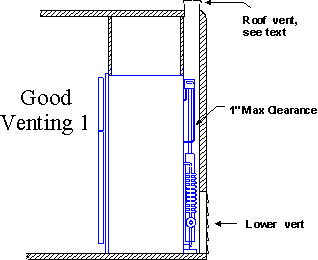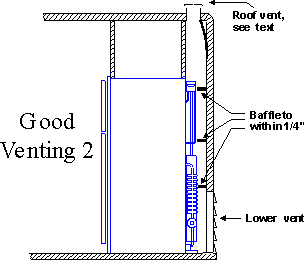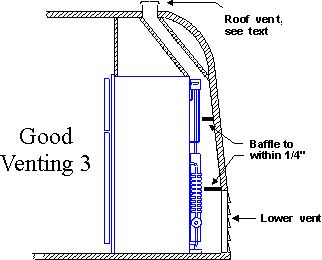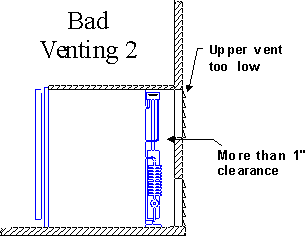Dave's Place
Venting
The venting of an RV gas/electric refrigerator should be designed to not only provide a place for the warm air from the cooling unit to escape, but designed to actually create a draft that will remove expelled heat as efficiently as possible. Poor venting can cause the cooling unit to overheat and damage the cooling unit.
When the cooling unit gives off heat, it causes air around it to warm. Warm air rises causing cooler air from the lower vent to enter the area and to extract more heat from the cooling unit and also rise. The greater the difference in temperature between the warmer air and the cooler air, the faster the air will rise. Narrowing the path of the air flow forces the cooler air through the cooling unit coils as it rises.
When installing a refrigerator, it's also a good idea to isolate the sides and the top of the refrigerator from the rear, preventing heat from accumulating around the box and hampering the effect of the refrigerator wall insulation.
The roof vent, which caps off the venting, keeps the rain out but allows for good air flow. The roof vent is centered over the cooling unit and is as at least as long as the cooling unit is wide.

In the venting side views below, the roof vent appears to be fairly small. But, in the front view above, you can see that it covers the entire width of the cooling unit.
Fans
Theoretically, perfect venting will create a draft that will remove heat from the cooling unit in even the
warmest conditions. However, perfect venting isn't always that easy to achieve. The purchase of an add-on
fan can solve a lot of problems in border line venting, but is not a cure all for terrible venting. The
important thing to remember is that the fan should be installed above the cooling unit, preferably right
at the roof vent. The purpose of the fan is to improve the draft, not to blow air onto the cooling unit.
Below are three examples of good venting under different situations.



Bad Venting:
The picture below demonstrates two venting problems. The distance between the cooling unit and the outer
wall is greater than 1" allowing air to by-pass the cooling unit. Besides not extracting heat from the coils,
cooler air by-passing the cooling unit tends to cool the warmer air at the upper levels and weaken the draft.
Also, there is a dead air space above the refrigerator. A dead air space or cavity at the top of the refrigerator
causes warm air to accumulate, drastically reducing air flow.

It's best if the upper roof vent is top mounted. Sometimes circumstances prevent the use of a top mounted vent, and an upper side vent is the only solution. An upper side vent will work if done properly and only with the smaller refrigerators (5 cubic feet or less). Below are the right way and the wrong way to do this.


RV Refrigerator Home
This RV refridgerator information was originally located on rvmobile.comRV Mobile Inc. 11715 HWY 99, Everett, WA 98204
The owner of RV Mobile Inc. apparently suffered a heart attack and the original website was shut down.
It has been reposted here to preserve this wealth of information RV refridgerator information.